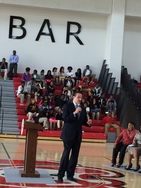Innovations at Dunbar High School have sparked progress, but there’s still a lot of student churn

Mayor Gray at Dunbar. Photo by the author.
Last week, Dunbar High School celebrated a dramatic rise in test scores with a pep rally featuring some of its alumni, including Mayor Vincent Gray. Other troubled DC high schools could learn something from Dunbar’s experience, but student churn is still a problem.
Dunbar, located in Truxton Circle near Union Station, was an elite black high school in the era of segregation. More recently it’s fallen on hard times, with some alumni proposing earlier this year that it recapture its glory days by becoming a selective school.
But Principal Stephen Jackson seems to be turning the school around. Last year, Dunbar’s gains on DC’s standardized tests were the largest of any high school in the DC Public School system. Dunbar’s proficiency rate on the reading section of the test went up by a whopping 23%, to 41%. That put it third in reading scores for neighborhood high schools, still 30 percentage points below Wilson, but just one point below Eastern.
Dunbar’s math proficiency rate also went up, by seven points, to 24%. While that increase may look modest compared to the gain in reading, it’s still significant.
Innovations that boosted scores
What’s behind the rise in scores? According to a press release, Dunbar has introduced a number of innovations, including weekly “inter-visitations among teachers on best practices.” Two recent best-selling books on education have argued that that kind of teacher-to-teacher observation and collaboration is crucial.
Dunbar administrators have also been visiting classrooms “on a daily basis,” according to the release. The DCPS teacher evaluation system requires five observations a year, with only some by a school administrator. But more frequent and regular observations by someone who knows the teacher well may be less threatening and more helpful.
Dunbar has also extended the school day for 9th and 10th graders, and students at risk of failing have been attending school on Saturdays.
In addition, the school has divided itself into five “academies,” each with a different theme. That, according to Dunbar math teacher David Tansey, has helped create “interconnectedness” between students and teachers.
Ninth Grade Academy
But one innovation has been trumpeted above the rest: Dunbar’s Ninth Grade Academy. Ninth grade is a bottleneck year in many DC high schools, because students have to pass algebra and English to advance to 10th grade. Generally, only about 60% make it.
That has led to 9th grade classes that include many older students repeating for the second or third time. Four years ago, Principal Jackson started separating the repeaters from the first-time 9th-graders, putting the repeaters into a “twilight academy” that met after school.
The Dunbar experiment looked promising enough that last year, DCPS Chancellor Kaya Henderson expanded it to eight other high schools. In addition to isolating the newbie 9th-graders from the sometimes jaundiced repeaters, the Ninth Grade Academy at Dunbar gives them a double dose of math and English. It also requires students to participate in extra-curricular activities and sports.
While it’s hard to say how much of Dunbar’s rise in scores is attributable to its Ninth Grade Academy, the school is trumpeting another statistic. It says that 98% of its first Ninth Grade Academy cohort, now in 12th grade, is on track to graduate. Considering that DCPS’s overall graduation rate is more like 60%, that’s an astounding figure.
But according to the Washington Post, almost half of the original 75 students in the cohort—36 of them—have left the school. It’s not clear how many of them are now on track to graduate. It’s also not clear how many other students have joined the class since 9th grade, and where those students stand academically. I put that question and others to school officials but didn’t get a response.
Student mobility
Student mobility is a major problem in DC, and Dunbar isn’t the only school that suffers from it. At Anacostia High School, for example, students entering midyear were at least 29% of the student body by May of last year, with 22% having exited. At Dunbar, the figures were 18% for midyear entries and 14% for withdrawals.
A report released last year by the Office of the State Superintendent of Education revealed that thousands of students were moving in and out of schools midyear, and a recent report on graduation rates found that 30% of DC students begin and end their high school careers at different schools.
Each switch results in a 10% decrease in the chances of a student graduating on time, according to the report. It’s also hugely disruptive for schools to get a constant influx of new students.
Perhaps attrition rates at Dunbar for more recent 9th-grade cohorts have been lower. Tansey, who started teaching in Dunbar’s Ninth Grade Academy during its second year of operation, says the first year was a little rocky, and that the number of entering freshmen has grown since then. Last year, he says, it was 120.
Tansey says the Academy helps the school keep track of its entering freshmen. “We can say, these are Dunbar kids,” he says. “We’ve made a commitment to them.”
He also says the creation of the Academy has reduced teacher turnover at that level. Before, he says, there was a new team of 9th grade teachers every year. And it’s helped with “backward-mapping,” enabling teachers to ensure students are prepared for the demands of 10th grade.
While Dunbar clearly still has a long way to go, there was justifiable pride in the cheers of “We Are Dunbar!” that resounded at last week’s pep rally. But for those 36 former 9th-graders who have moved elsewhere, and for many other DC students like them, it’s not yet clear that cheers are in order.
